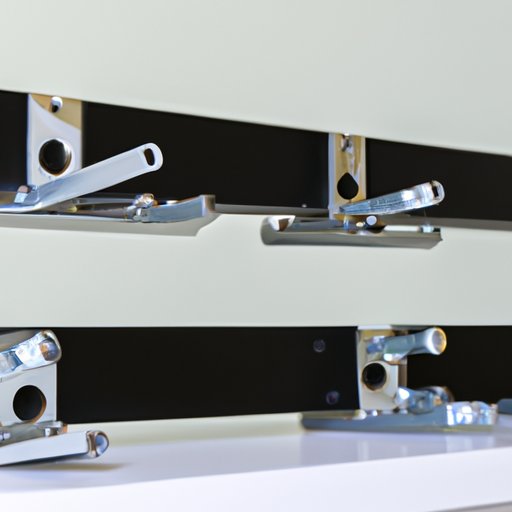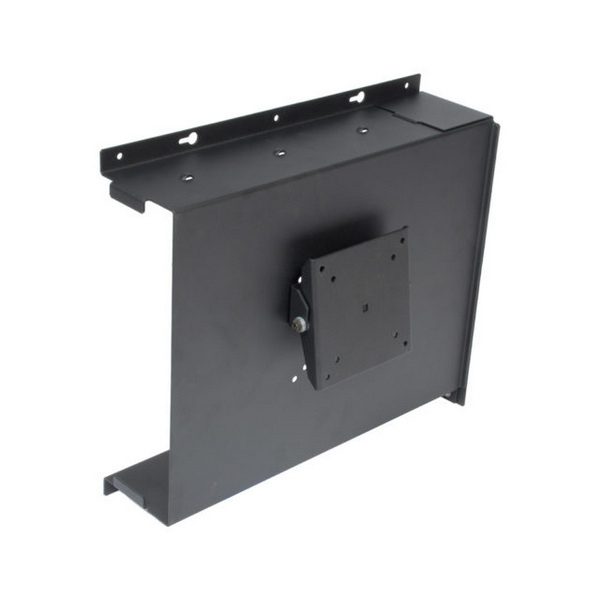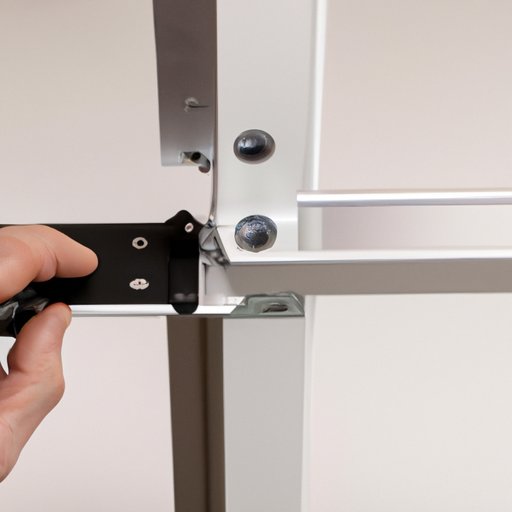Content Menu
● Understanding VESA Mounts
● What Are Aluminum Extrusion VESA Mounts?
● What Are Traditional VESA Mounts?
● Key Differences Between Aluminum Extrusion and Traditional VESA Mounts
>> 1. Material and Weight
>> 2. Customization and Modularity
>> 3. Aesthetics
>> 4. Installation and Adjustability
>> 5. Durability and Longevity
● Pros and Cons of Aluminum Extrusion VESA Mounts
>> Pros
>> Cons
● Pros and Cons of Traditional VESA Mounts
>> Pros
>> Cons
● Choosing the Right Mount for Your Needs
● Conclusion
● Frequently Asked Questions
>> 1. What is the weight capacity of aluminum extrusion VESA mounts?
>> 2. Can I use an aluminum extrusion VESA mount for a TV?
>> 3. Are aluminum extrusion mounts more expensive than traditional mounts?
>> 4. How do I install a VESA mount?
>> 5. Do traditional mounts offer any advantages over aluminum extrusion mounts?
Understanding VESA Mounts
VESA (Video Electronics Standards Association) mounts are standardized mounting interfaces that allow monitors and TVs to be securely attached to walls or stands. The VESA standard specifies the distance between mounting holes on the back of the display, ensuring compatibility with various mounting solutions. This standardization has made it easier for consumers to find compatible mounts for their devices, leading to a wide variety of options in the market.

What Are Aluminum Extrusion VESA Mounts?
Aluminum extrusion VESA mounts are constructed from aluminum profiles that are designed to be lightweight yet sturdy. These mounts are often modular, allowing for customization and flexibility in design. The extrusion process creates a strong, uniform structure that can support various monitor sizes and weights. The versatility of aluminum extrusion mounts makes them suitable for both home and professional environments, where aesthetics and functionality are equally important.
What Are Traditional VESA Mounts?
Traditional VESA mounts are typically made from steel or other metals and come in various fixed or adjustable designs. They are often simpler in construction and may not offer the same level of customization as aluminum extrusion mounts. Traditional mounts can be either wall-mounted or used with stands, providing a range of options for different setups. While they serve their purpose effectively, they may not always meet the needs of users looking for a more tailored solution.
Key Differences Between Aluminum Extrusion and Traditional VESA Mounts
1. Material and Weight
Aluminum extrusion mounts are lighter than traditional steel mounts, making them easier to handle and install. The lightweight nature of aluminum does not compromise strength; in fact, aluminum is known for its excellent strength-to-weight ratio. This makes aluminum mounts ideal for wall installations where weight is a concern. Additionally, the lightweight design can reduce the strain on walls and mounting surfaces, ensuring a more secure installation.
2. Customization and Modularity
One of the standout features of aluminum extrusion mounts is their modularity. Users can customize their setups by adding or removing components as needed. This flexibility allows for unique configurations that can adapt to changing workspace requirements. For instance, if a user decides to upgrade to a larger monitor, they can easily adjust the mount without needing to purchase a new one. Traditional mounts, while functional, often lack this level of customization, which can lead to limitations in how they can be used over time.
3. Aesthetics
Aluminum extrusion mounts often have a sleek, modern appearance that can enhance the overall look of a workspace. The clean lines and finish of aluminum can complement contemporary office designs. In contrast, traditional mounts may have a bulkier appearance, which can detract from the aesthetic appeal of a setup. For businesses that prioritize design and branding, the choice of mount can significantly impact the overall impression of the workspace.
4. Installation and Adjustability
Aluminum extrusion mounts typically offer more adjustability than traditional mounts. Many models allow for easy height and angle adjustments, enabling users to find the perfect viewing position. This is particularly beneficial in environments where multiple users share the same workspace, as it allows for quick adjustments to accommodate different preferences. Traditional mounts may require more effort to adjust, especially if they are fixed in place, which can be inconvenient in dynamic work environments.
5. Durability and Longevity
Both aluminum extrusion and traditional mounts are designed to be durable, but aluminum has the added benefit of being resistant to corrosion and rust. This makes aluminum mounts suitable for various environments, including those with high humidity or exposure to moisture. Traditional mounts may require more maintenance to prevent rusting over time, especially in coastal areas or places with high humidity. The longevity of aluminum mounts can lead to cost savings in the long run, as they may not need to be replaced as frequently.
Pros and Cons of Aluminum Extrusion VESA Mounts
Pros
- Lightweight and Easy to Install: The lightweight nature of aluminum makes installation straightforward, often requiring only basic tools.
- Customizable: Users can modify their setups easily to accommodate different monitors or workspace configurations, making them ideal for evolving needs.
- Modern Aesthetic: Aluminum mounts often have a sleek, contemporary look that enhances office decor, appealing to design-conscious users.
- Durable: Resistant to corrosion, ensuring longevity in various environments, which is particularly beneficial for businesses.
Cons
- Cost: Aluminum extrusion mounts can be more expensive than traditional mounts due to their advanced design and materials.
- Availability: Depending on the region, aluminum mounts may not be as readily available as traditional options, which can limit choices for consumers.

Pros and Cons of Traditional VESA Mounts
Pros
- Cost-Effective: Traditional mounts are often less expensive, making them accessible for budget-conscious consumers or businesses.
- Simplicity: The straightforward design of traditional mounts can be appealing for users who prefer a no-frills approach, allowing for quick installation and use.
Cons
- Limited Customization: Traditional mounts may not offer the same level of flexibility and customization as aluminum extrusion mounts, which can be a drawback for users with specific needs.
- Heavier: The weight of steel mounts can make installation more challenging and may require additional support, especially for larger monitors.
Choosing the Right Mount for Your Needs
When deciding between aluminum extrusion VESA mounts and traditional mounts, consider the following factors:
1. Workspace Requirements: Assess the layout of your workspace and how many monitors you plan to use. If you need a flexible setup, aluminum extrusion mounts may be the better choice. For static setups, traditional mounts might suffice.
2. Budget: Determine your budget for mounting solutions. If cost is a primary concern, traditional mounts may be more suitable. However, consider the long-term investment of aluminum mounts, which may save money over time due to their durability.
3. Aesthetic Preferences: Consider the overall look you want to achieve in your workspace. Aluminum mounts can provide a modern touch, while traditional mounts may be more utilitarian. The choice can impact the overall ambiance of your office.
4. Installation Ease: If you prefer a straightforward installation process, weigh the ease of installation for both types of mounts. Aluminum mounts often come with clear instructions and require minimal tools.
5. Future Needs: Think about potential changes in your workspace. If you anticipate needing to adjust or expand your setup, aluminum extrusion mounts offer greater flexibility. Traditional mounts may limit your options if you decide to upgrade your equipment.
Conclusion
In conclusion, both aluminum extrusion VESA mounts and traditional mounts have their unique advantages and disadvantages. Aluminum extrusion mounts stand out for their lightweight, customizable design and modern aesthetics, making them ideal for dynamic workspaces. Traditional mounts, while cost-effective and simple, may not offer the same level of flexibility.
Ultimately, the choice between the two will depend on your specific needs, preferences, and budget. By understanding the differences and considering your workspace requirements, you can select the mounting solution that best fits your situation.

Frequently Asked Questions
1. What is the weight capacity of aluminum extrusion VESA mounts?
Aluminum extrusion VESA mounts can typically support a wide range of monitor weights, often up to 30-50 pounds, depending on the specific model. It is essential to check the manufacturer's specifications for exact weight limits.
2. Can I use an aluminum extrusion VESA mount for a TV?
Yes, as long as the TV is compatible with the VESA mounting standard, aluminum extrusion mounts can be used for TVs as well. This versatility makes them a great option for both monitors and televisions.
3. Are aluminum extrusion mounts more expensive than traditional mounts?
Generally, yes. Aluminum extrusion mounts tend to be more expensive due to their advanced materials and customizable features. However, the investment may be worthwhile for users seeking durability and flexibility.
4. How do I install a VESA mount?
Installation typically involves securing the mount to a wall or desk using screws and brackets, then attaching the monitor or TV to the mount according to the manufacturer's instructions. Most mounts come with detailed installation guides to assist users.
5. Do traditional mounts offer any advantages over aluminum extrusion mounts?
Traditional mounts are often more cost-effective and simpler in design, making them suitable for users who prefer a straightforward solution without the need for customization. They can be a good choice for static setups where flexibility is not a priority.






















